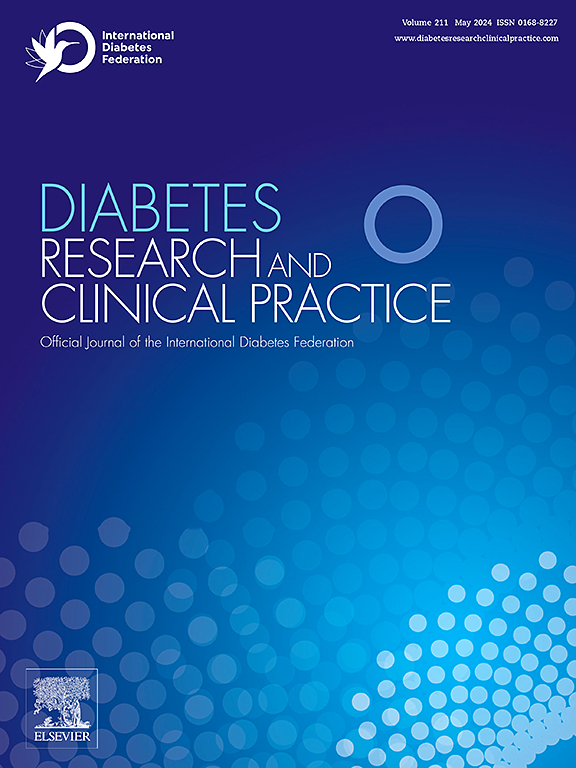IF 6.1
3区 医学
Q1 ENDOCRINOLOGY & METABOLISM
引用次数: 0
摘要
目的:比较不同运动方式对血糖控制的益处大小,包括有氧训练(AT)、阻力训练(RT)、综合训练(CT)、高强度间歇训练(HIIT)和体育锻炼建议:方法:进行了一项网络荟萃分析。方法:我们进行了一项网络荟萃分析,检索了从开始到 2024 年 5 月的七个数据库。我们纳入了至少为期 12 周的随机临床试验,这些试验评估了不同类型的体育锻炼和体育锻炼建议对降低 2 型糖尿病患者 HbA1c 的作用:结果:共纳入 158 项研究(17059 名参与者)。与对照组相比,所有类型的运动都能降低 HbA1c:HIIT [-0.61 % (95 % CrI -0.84; -0.37)]、CT [-0.58 % (95 % CrI -0.73; -0.42]]、AT [-0.58 % (95 % CrI -0.70; -0.45)]、RT [-0.40 % (95 % CrI -0.59; -0.21)]和体育锻炼建议 [-0.35 % (95 % CrI -0.53; -0.16)]。HIIT 是降低 HbA1c 最有效的治疗方法(SUCRA = 82 %),其次是 CT(SUCRA = 77 %)、AT(SUCRA = 76 %)、RT(SUCRA = 37 %)和体育锻炼建议(SUCRA = 29 %):结论:HIIT 与 HbA1c 的最大降幅相关。体育锻炼建议易于实施、容易获得且无人监督,也应提供给 2 型糖尿病患者,以改善血糖控制。本文章由计算机程序翻译,如有差异,请以英文原文为准。
Effects of exercise training and physical activity advice on HbA1c in people with type 2 diabetes: A network meta-analysis of randomized controlled trials
Aims
To compare the magnitude of the benefit of different exercise modalities on glycemic control, including aerobic training (AT), resistance training (RT), combined training (CT), high-intensity interval training (HIIT) and physical activity advice.
Methods
A network meta-analysis was conducted. Seven databases were searched from inception to May 2024. We included randomized clinical trials of at least 12 weeks’ duration evaluating different types of physical exercise and physical activity advice to reduce HbA1c in people with type 2 diabetes.
Results
158 studies (17,059 participants) were included. Compared with the control group, all types of exercise were associated with lower HbA1c: HIIT [−0.61 % (95 % CrI −0.84; −0.37)], CT [−0.58 % (95 % CrI −0.73; −0.42], AT [−0.58 % (95 % CrI −0.70; −0.45)], RT [−0.40 % (95 % CrI −0.59; −0.21)] and physical activity advice [−0.35 % (95 % CrI −0.53; −0.16)]. HIIT was the most effective treatment for HbA1c reduction (SUCRA = 82 %), followed by CT (SUCRA = 77 %), AT (SUCRA = 76 %), RT (SUCRA = 37 %) and physical activity advice (SUCRA = 29 %).
Conclusions
HIIT was associated with the greatest reduction in HbA1c. Physical activity advice, which is easy to implement, accessible and unsupervised, should also be offered to people with type 2 diabetes to improve glycemic control.
求助全文
通过发布文献求助,成功后即可免费获取论文全文。
去求助
来源期刊

Diabetes research and clinical practice
医学-内分泌学与代谢
CiteScore
10.30
自引率
3.90%
发文量
862
审稿时长
32 days
期刊介绍:
Diabetes Research and Clinical Practice is an international journal for health-care providers and clinically oriented researchers that publishes high-quality original research articles and expert reviews in diabetes and related areas. The role of the journal is to provide a venue for dissemination of knowledge and discussion of topics related to diabetes clinical research and patient care. Topics of focus include translational science, genetics, immunology, nutrition, psychosocial research, epidemiology, prevention, socio-economic research, complications, new treatments, technologies and therapy.
 求助内容:
求助内容: 应助结果提醒方式:
应助结果提醒方式:


